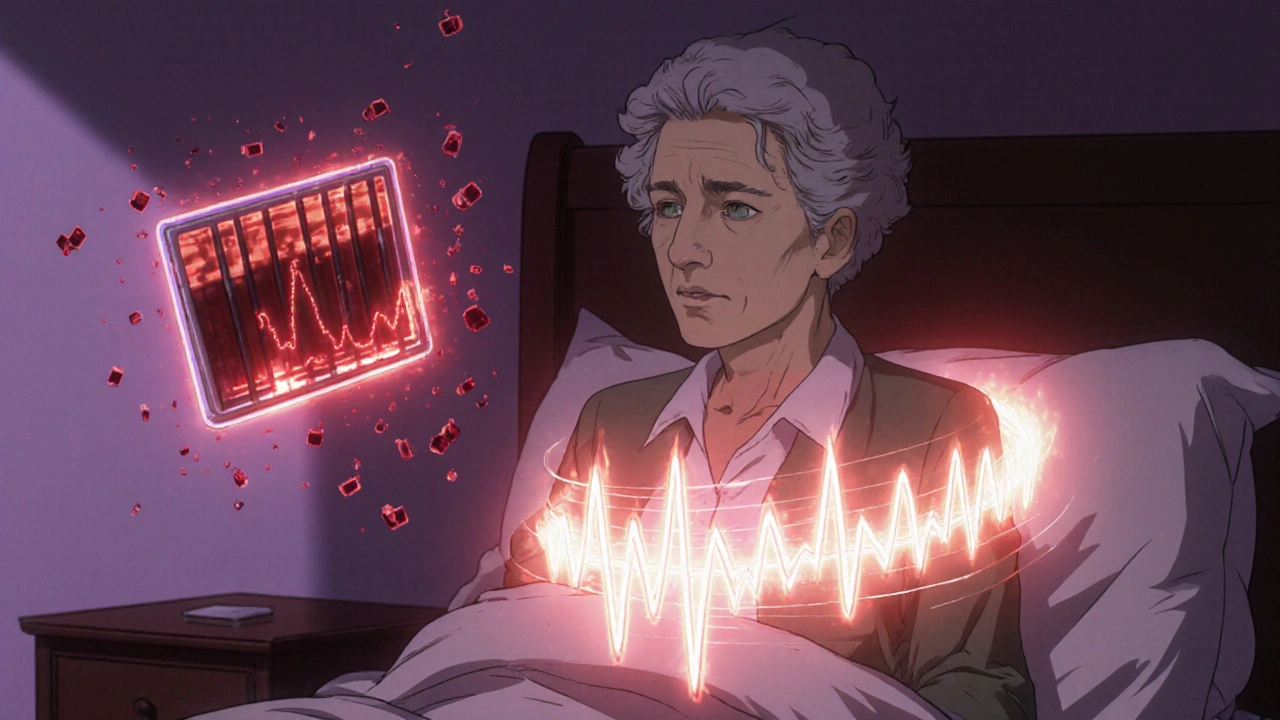QT Prolongation Risk Calculator
This tool assesses your patient's cardiac risk for hydroxyzine-induced QT prolongation based on current clinical guidelines.
Quick Takeaways
- Hydroxyzine can lengthen the QT interval, especially at higher doses or in vulnerable patients.
- Risk is linked to hERG potassium‑channel blockade, which slows cardiac repolarisation.
- Regulators now cap the daily dose at 100 mg for adults and 50 mg for the elderly.
- Before prescribing, verify QTc < 450 ms (men) or < 470 ms (women) and check for interacting meds.
- Alternative antihistamines (cetirizine, loratadine) have minimal QT effect.
When you hear the name hydroxyzine is a first‑generation antihistamine that also acts as a sedative and anxiolytic. It has been on the market since the 1950s and is sold under brand names like Atarax and Ucerax. While it’s effective for itching, anxiety, and nausea, a growing body of evidence shows it can interfere with the heart’s electrical system, specifically by prolonging the QT interval.
The QT interval measures the time it takes for the heart’s ventricles to repolarise after each beat. A prolonged QT can spiral into Torsade de Pointes, a dangerous, twisting ventricular rhythm that may lead to sudden cardiac death. This article walks through the science, the clinical data, and practical steps to keep patients safe when hydroxyzine is needed.
How Hydroxyzine Affects Cardiac Repolarisation
Research from the NIH and the European Medicines Agency (EMA) points to hydroxyzine’s inhibition of the human ether‑a‑go‑go‑related gene (hERG potassium channel) as the primary culprit. The hERG channel conducts potassium out of cardiac cells during phase 3 of the action potential. When hydroxyzine binds inside the channel’s inner cavity, it slows potassium efflux, extending phase 3 and thus lengthening the QT interval.
In vitro studies report an IC50 (the concentration that halves the channel activity) within the therapeutic plasma range of hydroxyzine, meaning normal doses can already affect the channel. The effect is dose‑dependent: higher plasma levels produce greater blockade, and the drug’s half‑life of 14-25 hours allows accumulation, especially in the elderly or those with liver impairment.
Evidence from Clinical Cases and Pharmacovigilance
Post‑marketing surveillance since the early 2000s has collected dozens of reports linking hydroxyzine to QT prolongation and Torsade de Pointes. A European review published in 2015 identified 59 distinct cases, while more recent case reports describe events occurring after doses as low as 12.5 mg and as high as 225 mg.
Highlights include:
- A 68‑year‑old woman on 50 mg hydroxyzine plus amiodarone developed TdP within hours, requiring emergency cardioversion (Cureus, 2022).
- A 45‑year‑old man with undiagnosed long QT syndrome fainted 15 minutes after a 25 mg dose (Journal of Medical Case Reports, 2019).
- Reddit’s r/Pharmacy community recorded 37 personal anecdotes of palpitations or dizziness within an hour of dosing (2018‑2023).
These reports underscore two patterns: rapid onset (minutes to hours) in patients with underlying susceptibility, and delayed onset (days) when the drug accumulates.
Regulatory Response and Dose Restrictions
In response to the emerging safety signal, the EMA’s Pharmacovigilance Risk Assessment Committee (PRAC) cut the maximum adult daily dose from previous higher limits to 100 mg in 2015. For patients over 65 years, the ceiling dropped further to 50 mg, and pediatric dosing is now weight‑based (2 mg/kg up to 40 kg). The U.S. FDA added hydroxyzine to its “List of Drugs with QTc Prolongation Risk” in 2019, mandating a boxed warning and explicit guidance on ECG monitoring.
These changes have already shifted prescribing behaviour. A 2017 pharmaco‑epidemiology study showed a 37 % drop in hydroxyzine prescriptions to elderly patients within a year of the EMA’s recommendation. Yet the drug still accounts for 12.7 million outpatient fills in the United States in 2022, reflecting its entrenched role for anxiety and pruritus.

Assessing Cardiac Risk Before Starting Hydroxyzine
Clinicians now follow a structured risk‑assessment algorithm:
- Obtain a baseline 12‑lead ECG. Ensure QTc < 450 ms (men) or < 470 ms (women). If QTc > 500 ms, avoid hydroxyzine.
- Review the patient’s medication list using the CredibleMeds database. Hydroxyzine is classified as “Known Risk of TdP.” Flag any co‑prescribed QT‑prolonging agents (e.g., amiodarone, certain fluoroquinolones, citalopram).
- Check electrolytes-potassium < 4.0 mmol/L or magnesium < 1.8 mg/dL increases susceptibility.
- Identify clinical risk factors: age > 65, bradycardia < 50 bpm, structural heart disease, congenital long QT syndrome, or hepatic impairment.
- Decide on dosing: standard dose for patients with zero risk factors; half‑dose and close monitoring for one risk factor; avoid altogether for two or more.
Electronic health record (EHR) systems in many hospitals now place hard stops when a provider tries to order hydroxyzine for a patient with QTc > 500 ms or a documented “Known Risk” medication, forcing the prescriber to re‑evaluate.
Alternative Antihistamines with Lower Cardiac Risk
If the patient’s risk profile is moderate to high, consider switching to a second‑generation antihistamine. Comparative data (see table below) show:
| Drug | Generation | Typical QTc change | Regulatory risk classification |
|---|---|---|---|
| Hydroxyzine | First | +10 to +15 | Known Risk of TdP |
| Diphenhydramine | First | +5 to +10 | Possible Risk |
| Cetirizine | Second | +0 to +2 | Conditional Risk |
| Loratadine | Second | +0 to +1 | Conditional Risk |
| Citalopram (high dose) | SSRI | +10 to +20 | Known Risk of TdP |
When possible, preferring cetirizine or loratadine eliminates the need for intensive cardiac monitoring.
Special Populations: Elderly, Renal Failure, and Genetic Factors
Elderly patients are the most vulnerable because of slower drug clearance and a higher prevalence of electrolyte disturbances. Studies show a 78 % compliance rate with new documentation requirements in hospitals that mandate a cardiac risk note for every hydroxyzine order.
Renal or dialysis patients often have fluctuating potassium and magnesium levels, which can precipitate QT prolongation. A survey of nephrology nurses reported unexplained cardiac events in 14 % of hydroxyzine doses given within a 24‑hour window.
Pharmacogenomics is emerging as another layer of risk stratification. A 2023 pharmacogenomics study linked CYP2D6 poor‑metaboliser status to a three‑fold increase in QT‑prolongation odds when hydroxyzine is used. While routine testing isn’t standard yet, it may become part of personalized prescribing in the next few years.

Practical Prescribing Checklist
- Confirm indication - short‑term use (≤ 7 days) preferred.
- Check baseline ECG and electrolytes.
- Review concurrent meds via CredibleMeds.
- Apply dose limits: 100 mg/day (adults), 50 mg/day (≥ 65 y), weight‑based for children.
- Document risk assessment in the medical record.
- If any risk factor present, order repeat ECG 24‑48 hours after the first dose.
- Educate patient to report palpitations, dizziness, or syncope immediately.
Future Directions and Ongoing Research
Scientists are exploring hydroxyzine analogs that retain antihistamine potency while sparing the hERG channel. One candidate, VH‑01, showed an 87 % reduction in hERG inhibition in Phase I trials, hinting at a safer next‑generation product.
A 2024 clinical trial (NCT05678912) is testing whether routine ECG monitoring in patients with a single risk factor cuts the incidence of cardiac events by half. Early interim data suggest that proactive monitoring leads to earlier dose adjustments and fewer emergency visits.
Guideline updates are on the horizon. The European Society of Cardiology’s 2025 recommendations are expected to restrict hydroxyzine to single‑dose procedural anxiety, effectively eliminating chronic use in most settings.
Bottom Line for Clinicians
Hydroxyzine remains a useful drug for itch, anxiety, and nausea, but it’s no longer a “plug‑and‑play” antihistamine. The cardiac risk, while modest, becomes real in patients with existing QT concerns, electrolyte imbalances, or concurrent QT‑prolonging meds. By following a simple ECG‑based checklist, staying within dose limits, and choosing safer alternatives when appropriate, prescribers can keep the benefits while minimizing the heart‑related danger.
Can a single dose of hydroxyzine cause QT prolongation?
Yes. In highly susceptible individuals-especially those with congenital long QT syndrome or on other QT‑prolonging drugs-even a 25 mg dose can produce a measurable QT increase within minutes.
How does hydroxyzine’s effect compare to diphenhydramine?
Both block hERG, but diphenhydramine’s IC50 is higher, leading to a slightly smaller QTc change (+5 to +10 ms) versus hydroxyzine’s +10 to +15 ms on average.
What electrolyte levels are considered unsafe with hydroxyzine?
Potassium below 4.0 mmol/L or magnesium under 1.8 mg/dL markedly raise the risk of QT prolongation and should be corrected before starting the drug.
Is routine ECG monitoring required for every patient?
Current guidelines recommend a baseline ECG for anyone with a risk factor, and a follow‑up ECG 24‑48 hours after the first dose if the initial QTc is near the upper normal limit.
What are safer antihistamine alternatives?
Second‑generation agents such as cetirizine, loratadine, and fexofenadine have negligible hERG activity and are preferred for patients with any cardiac concerns.

